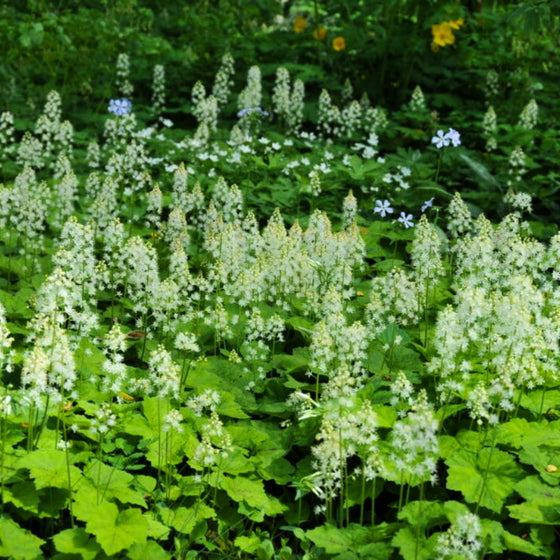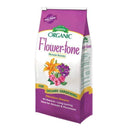
Images Depict Mature Plants
Tiarella Cordifolia Plants for Sale Online
Tiarella cordifolia, commonly known as Foamflower, is a stunning native perennial that adds a touch of woodland charm to any garden. With its heart-shaped, deeply lobed leaves that feature a mix of green and burgundy tones, this shade-loving plant creates a striking ground cover. In spring, Tiarella cordifolia produces delicate, frothy spikes of white or pale pink flowers that resemble tiny stars, giving it the enchanting name of "Foamflower." These blooms not only add beauty but also attract pollinators such as bees and butterflies, making Tiarella cordifolia an excellent choice for those looking to support local wildlife.
Ideal for shade or woodland gardens, Tiarella cordifolia thrives in moist, well-drained soil and can adapt to partial or full shade. Its versatility makes it perfect for use as an underplanting beneath deciduous trees or as an edging plant along shaded pathways. The vibrant foliage of Foamflower remains evergreen in milder climates, providing year-round interest even after the flowers have faded. This perennial is also deer-resistant, making it a reliable addition to landscapes where deer browsing is a concern.
Whether used as a ground cover, in a mixed perennial border, or as a container plant, Tiarella cordifolia offers low-maintenance beauty and texture. Its rapid growth rate helps it quickly establish a lush carpet of foliage that suppresses weeds, reducing the need for maintenance in shaded areas. Foamflower is a popular choice for native and pollinator-friendly gardens, blending seamlessly with other shade perennials like hostas, ferns, and heucheras. Add Tiarella cordifolia to your garden for a burst of seasonal color and lush, textured foliage that will captivate throughout the year.

| Hardiness Zone: | 4-9 |
|---|---|
| Mature Height: | 12 Inches |
| Mature Width: | 12 to 18 Inches |
| Classification: | Perennial |
| Sunlight: | Part sun to full shade |
| Water Requirements: | Low |
| Flower Color: | White |
| Habit: | Clumping |
How to Care for Tiarella Cordifolia
After purchasing your Tiarella Cordifolia, be sure to read our recommended care instructions to guarantee a happy and healthy plant.
How do I plant my Tiarella Cordifolia?
To plant your Tiarella cordifolia, also known as foamflower, start by selecting a location that provides partial to full shade, as this native woodland perennial thrives in low-light conditions. Tiarella cordifolia prefers rich, well-drained soil that is consistently moist but not waterlogged. If your soil is heavy or compacted, amend it with organic matter like compost or leaf mold to improve both drainage and fertility. Dig a hole slightly larger than the plant's root ball, ensuring the top of the root ball sits level with the surrounding ground. Gently loosen the roots before placing the plant in the hole, then backfill with soil, pressing it down lightly to remove any air pockets. Once planted, water thoroughly to help the roots establish in their new environment. After planting, apply a 2-3 inch layer of organic mulch around the base of the Tiarella cordifolia to help retain moisture, regulate soil temperature, and suppress weed growth. Be sure to keep the mulch a few inches away from the crown of the plant to prevent rot. During the first growing season, keep the soil evenly moist to ensure proper root establishment—this is especially important in the drier months. Tiarella cordifolia is a low-maintenance groundcover that spreads through underground runners, making it a great choice for filling shaded garden areas, borders, or woodland gardens. By providing it with the right planting conditions, your foamflower will thrive, forming a beautiful carpet of attractive foliage and delicate, frothy white blooms in spring.
How do I water my Tiarella Cordifolia?
To properly water your Tiarella cordifolia, also known as foamflower, it is important to keep the soil consistently moist, especially during the first growing season as the plant establishes its roots. Tiarella cordifolia thrives in conditions similar to its native woodland habitat, where the soil remains damp but not waterlogged. Water the plant deeply once or twice a week, depending on weather conditions, making sure the moisture penetrates the root zone. During periods of hot or dry weather, increase the frequency of watering to prevent the soil from drying out completely. However, avoid overwatering, as foamflower does not tolerate standing water or soggy soil, which can lead to root rot. Once Tiarella cordifolia is established, it becomes more tolerant of occasional dry spells but will still benefit from regular watering, especially during hot, dry periods or when grown in sunnier spots. Applying a 2-3 inch layer of organic mulch around the base of the plant helps to retain soil moisture, regulate temperature, and reduce evaporation. Make sure to keep the mulch a few inches away from the plant’s crown to avoid causing rot. Consistent watering will support healthy foliage growth and encourage the production of the plant’s beautiful, frothy white blooms in spring. By maintaining the appropriate moisture level, your foamflower will flourish and provide an attractive groundcover in shaded areas of your garden.
How do I fertilize Tiarella Cordifolia?
To fertilize Tiarella cordifolia, also known as foamflower, begin in early spring just as new growth begins to emerge. Use a balanced, slow-release fertilizer, such as a 10-10-10 formula, to provide essential nutrients that will support lush foliage and robust blooms. Apply the fertilizer around the base of the plant, being careful not to let it touch the crown, which can lead to burn or rot. Spread the fertilizer evenly, and water thoroughly afterward to help the nutrients penetrate the soil and reach the root zone. Because Tiarella cordifolia naturally thrives in nutrient-rich woodland environments, a light application of fertilizer is generally sufficient to promote healthy growth. In addition to using a balanced fertilizer, enriching the soil with organic matter like compost or well-rotted leaf mold is highly beneficial for Tiarella cordifolia. Apply a layer of compost in early spring, which will slowly break down and provide consistent nutrients throughout the growing season. This organic matter helps improve soil structure and supports beneficial microorganisms, enhancing nutrient availability and overall plant health. Avoid over-fertilizing, as excessive nutrients can lead to overly vigorous foliage growth at the expense of flowering. By maintaining a moderate fertilization routine, your Tiarella cordifolia will thrive, displaying its beautiful, frothy white flower spikes and attractive foliage in shaded areas of your garden.

How do I Prune Tiarella Cordifolia?
Pruning Tiarella cordifolia, also known as foamflower, is a simple process that helps maintain the plant's appearance and promotes healthy growth. After the flowering period in late spring to early summer, prune away the spent flower stalks to keep the plant tidy and encourage new foliage growth. Use clean, sharp pruning shears to cut the flower stems back to the base of the plant, which helps prevent the plant from putting energy into seed production. Removing the faded flowers not only improves the appearance of your foamflower but also allows the plant to focus on expanding its attractive foliage, creating a lush and vibrant ground cover in shaded areas of your garden. Throughout the growing season, you should also remove any damaged, diseased, or yellowing leaves to keep the plant looking healthy and prevent the spread of pests or diseases. In late fall, once the temperatures begin to drop, consider giving the Tiarella cordifolia a light trim to remove any leggy or unruly growth. This helps maintain a neat and compact shape over winter. Additionally, applying a 2-3 inch layer of mulch around the base of the plant will help protect the roots and foliage from extreme temperatures. By pruning Tiarella cordifolia regularly, you encourage vigorous growth and ensure that the plant continues to provide a beautiful and dense carpet of foliage and delicate blooms year after year.















